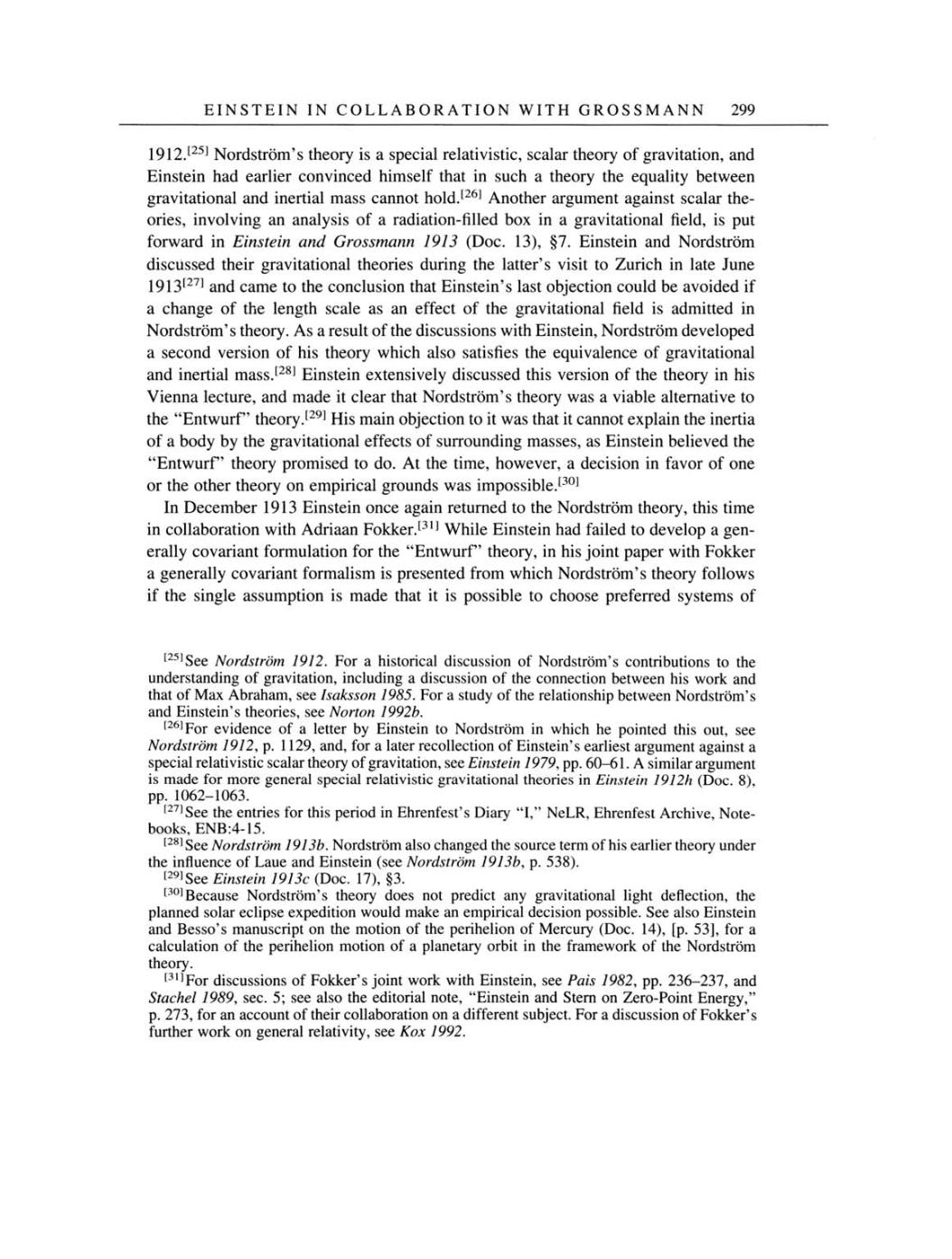EINSTEIN IN COLLABORATION WITH
GROSSMANN
299
1912.[25]
Nordstrom's
theory
is
a special
relativistic,
scalar
theory
of
gravitation,
and
Einstein had earlier convinced himself that
in
such
a
theory
the
equality
between
gravitational
and
inertial
mass
cannot hold.[26]
Another
argument against
scalar
the-
ories,
involving
an
analysis
of
a
radiation-filled
box in
a
gravitational field,
is
put
forward
in
Einstein and Grossmann
1913
(Doc. 13), §7.
Einstein
and Nordström
discussed their
gravitational
theories
during
the
latter's
visit to
Zurich
in late
June
1913[27]
and
came
to the
conclusion
that
Einstein's
last
objection
could
be
avoided if
a
change
of
the
length
scale
as an
effect of
the
gravitational
field is
admitted
in
Nordström's
theory.
As
a
result of
the
discussions
with Einstein,
Nordström
developed
a
second version of
his
theory
which
also satisfies the
equivalence
of
gravitational
and inertial
mass.[28]
Einstein
extensively
discussed
this
version of
the
theory
in
his
Vienna
lecture, and
made
it
clear
that
Nordström's
theory
was
a
viable alternative
to
the
"Entwurf"
theory.[29]
His
main
objection
to it
was
that
it cannot
explain
the
inertia
of
a body by
the
gravitational
effects of
surrounding masses, as
Einstein believed
the
"Entwurf"
theory
promised
to do.
At
the
time, however,
a
decision in favor of
one
or
the
other
theory on empirical
grounds
was
impossible.[30]
In
December
1913
Einstein
once
again
returned
to the
Nordström
theory,
this
time
in
collaboration
with
Adriaan
Fokker.[31]
While Einstein had
failed to
develop
a gen-
erally
covariant formulation for
the
"Entwurf"
theory,
in his
joint paper
with
Fokker
a
generally
covariant formalism
is
presented
from which Nordström's
theory
follows
if
the
single assumption
is made
that
it is
possible
to
choose
preferred systems
of
[25]See
Nordström
1912.
For
a
historical discussion of Nordstrom's
contributions
to
the
understanding
of
gravitation, including
a
discussion of
the
connection between
his work
and
that of Max
Abraham,
see
Isaksson
1985.
For
a study
of
the
relationship
between
Nordström's
and Einstein's
theories,
see
Norton
1992b.
[26]For
evidence of
a
letter
by
Einstein
to
Nordström
in
which
he
pointed
this
out,
see
Nordström
1912,
p.
1129, and,
for
a
later recollection of Einstein's earliest
argument against
a
special
relativistic scalar
theory
of
gravitation,
see
Einstein
1979,
pp.
60-61.
A
similar
argument
is
made for
more
general special
relativistic
gravitational
theories
in
Einstein
1912h
(Doc. 8),
pp.
1062-1063.
[27]See
the entries for
this
period
in
Ehrenfest's
Diary
"I," NeLR,
Ehrenfest
Archive,
Note-
books,
ENB:4-15.
[28]See
Nordström
1913b.
Nordström
also
changed
the
source
term
of
his
earlier
theory
under
the influence of Laue
and
Einstein
(see
Nordström
1913b,
p. 538).
[29]See
Einstein 1913c
(Doc. 17), §3.
[30]Because Nordström's
theory
does
not predict
any
gravitational light deflection,
the
planned
solar
eclipse expedition
would make
an
empirical
decision
possible.
See
also Einstein
and
Besso's
manuscript
on
the motion of
the
perihelion
of
Mercury (Doc. 14),
[p. 53],
for
a
calculation of the
perihelion
motion of
a
planetary
orbit
in the
framework of
the
Nordström
theory.
[31]For
discussions of Fokker's
joint
work with
Einstein,
see
Pais
1982,
pp.
236-237,
and
Stachel
1989, sec. 5;
see
also the editorial
note,
"Einstein
and Stern
on
Zero-Point
Energy,"
p.
273,
for
an
account
of their collaboration
on a
different
subject.
For
a
discussion of
Fokker's
further work
on
general relativity,
see
Kox 1992.
